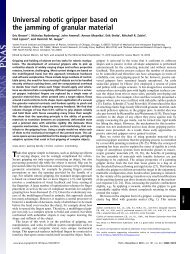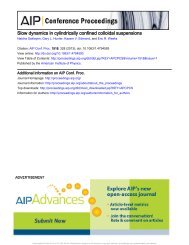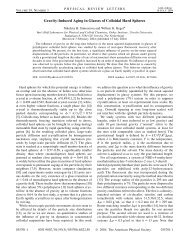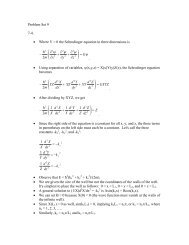Essay contest reveals misconceptions of high school ... - Genetics
Essay contest reveals misconceptions of high school ... - Genetics
Essay contest reveals misconceptions of high school ... - Genetics
You also want an ePaper? Increase the reach of your titles
YUMPU automatically turns print PDFs into web optimized ePapers that Google loves.
<strong>Genetics</strong> Education 1161TABLE 5Key ideas/subtopics used to categorize <strong>misconceptions</strong>TopicGenetic technologyDeterministic nature <strong>of</strong> genesPatterns <strong>of</strong> inheritanceNature <strong>of</strong> genes and genetic materialsGenetic basis <strong>of</strong> disease<strong>Genetics</strong> researchReproductive technologyKey ideas/subtopicsRealistic vs. nonrealistic uses‘‘Genohype’’Role <strong>of</strong> gene therapy in curing genetic diseaseGenes determine all traitsOne gene, one traitLack <strong>of</strong> environmental influenceLack <strong>of</strong> multigene involvement in traitsProbabilityTypes <strong>of</strong> inheritanceMisunderstanding modes <strong>of</strong> inheritanceInterpretation <strong>of</strong> data from Punnett squaresUnderstanding the origin <strong>of</strong> chromosomal anomalies(monosomies, trisomies)Role <strong>of</strong> different nucleic acids in geneticsCentral dogmaDescription <strong>of</strong> a geneChromosomes and genesDNA and living organismsMultigene involvement in diseaseEnvironmental influence in diseaseDifference between genetic and inherited diseaseDifference between viral, sexually transmitted,and genetic diseasesProcess <strong>of</strong> researchTime frame <strong>of</strong> researchTopics <strong>of</strong> researchEugenicsCloningPreimplantation genetic diagnosistions could be categorized under broad topics in genetics(summarized in Table 5). To quantify the frequency<strong>of</strong> these common <strong>misconceptions</strong> we reanalyzed500 (20%) <strong>of</strong> the essays, which included 250 essayschosen at random from each year’s submissions. Individual<strong>misconceptions</strong> were identified and cataloged.After cataloging each misconception in the 500 essaysand defining the categories <strong>of</strong> genetics in which theyfell, ‘‘common’’ categories were defined by those beingpresent in at least 5% <strong>of</strong> the essays examined. Of the 500systematically reviewed essays, 278 (55.6%) revealed atleast one obvious misconception. Another 101 essays(20.2%) were recognized for having two or more <strong>misconceptions</strong>.Misconceptions that were linked to essayswith obvious language or writing barriers were excludedfrom quantitative analysis to avoid overrepresentationin our quantitative analysis. The prevalence <strong>of</strong> <strong>misconceptions</strong>per topic area is summarized in Figure 2.Standards and common areas <strong>of</strong> <strong>misconceptions</strong>:Misconceptions were identified and categorized into ageneral topic area. We then examined how standardswere related to these main topic areas, specificallypatterns <strong>of</strong> inheritance and the deterministic nature <strong>of</strong>genes. We analyzed 20 sets <strong>of</strong> state biology standardsat random to determine the nature <strong>of</strong> the standards inpatterns <strong>of</strong> inheritance at the introductory biology orlife science level in <strong>high</strong> <strong>school</strong>. Supplemental Table 1at http://www.genetics.org/supplemental/ <strong>high</strong>lightsfour sets <strong>of</strong> these standards that provide a range <strong>of</strong>coverage <strong>of</strong> patterns <strong>of</strong> inheritance. A majority <strong>of</strong> thesebasic genetics/cell biology standards (15/20) includedan examination <strong>of</strong> Mendel’s laws <strong>of</strong> inheritance, somespecifically describing the requirement to understandprobability, Punnett squares, and the differences betweenautosomal dominant, autosomal recessive, andsex-linked traits. Other states included only more broaddescriptions where a student would, for example,‘‘Explain current scientific ideas and information aboutthe molecular and genetic basis <strong>of</strong> heredity’’ (see supplementalTable 1). These are important data becausethey reflect the <strong>high</strong>ly diverse nature <strong>of</strong> the level <strong>of</strong> detailrequired <strong>of</strong> students in U.S. <strong>high</strong> <strong>school</strong>s. While standardsthat fail to provide comprehensive detail allowtalented teachers to provide creative and challenginglearning opportunities for students, they can <strong>of</strong>tenalso result in learning experiences that fail to


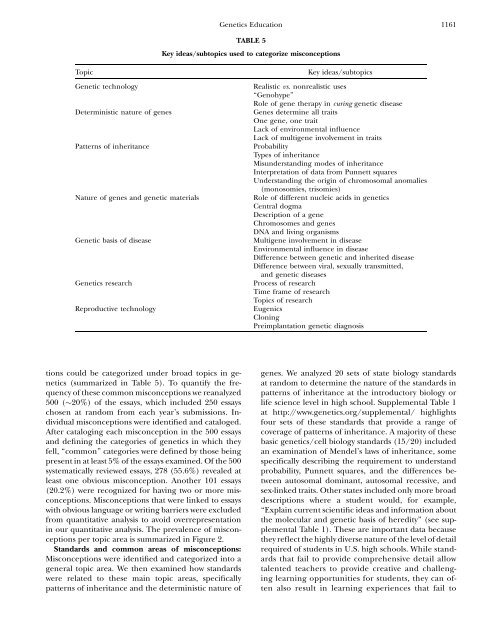
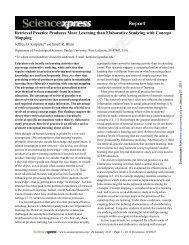
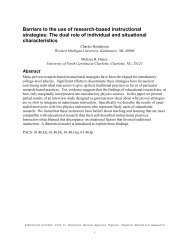
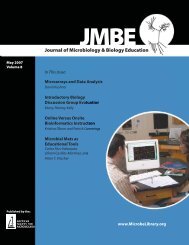
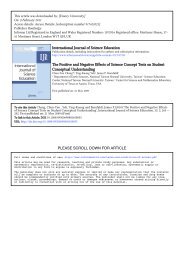
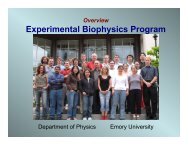
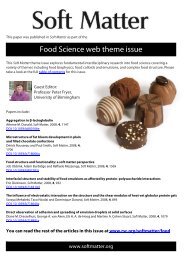

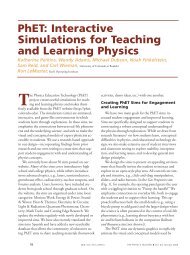
![view the Dish Show [PDF] - Department of Physics - Emory University](https://img.yumpu.com/45032745/1/190x146/view-the-dish-show-pdf-department-of-physics-emory-university.jpg?quality=85)

